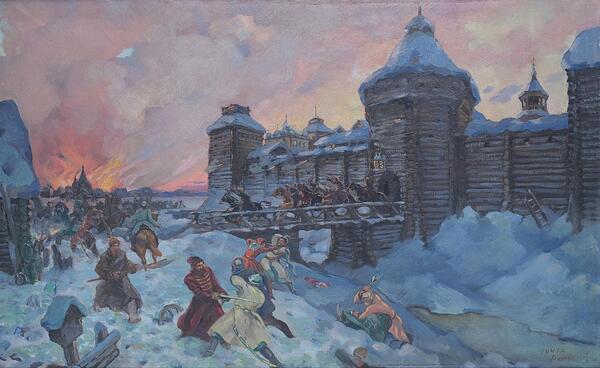Artist Alexey Rumyantsev depicted a historical event — the defense of Kargopol from Polish-Lithuanian invaders in 1612. The turn of the 17th century in the history of the Russian state is called the Time of Troubles: impostors and foreigners claimed the throne, Moscow and other cities were occupied by Polish-Lithuanian invaders, and in the north, the Swedes occupied Novgorod.
In the summer and autumn of 1612, a city fortification was hastily erected in Kargopol in place of the old settlement: it was almost a perfect square with a perimeter wall length of 1080 meters. The builders fenced the interior buildings from four sides with a wooden fence — logs with pointed tops vertically dug into the ground. It stood on high embankment ramparts. Ditches were dug from three sides, the fourth side was near the river. There were 8 towers on the ramparts, an artillery was located inside the prison. The garrison of the fortress consisted of 160 archers and 9 gunners.
After the Second People’s Militia liberated Moscow, Polish and Cossack formations began to move north. Thus began the intervention on the territory of Pomorye. In December 1612, Polish-Lithuanian interventionists approached Kargopol. They stormed the city for three days but could not conquer it: the Streltsy and local residents, led by the warlord, repelled all three enemy attacks.
On the morning of the third day, the defenders of the prison themselves made a sortie. It was this episode that the artist displayed.
In the center of the picture, the city walls are painted in close-up. They are poorly visible in the dawn light. On the bridge over the moat, horsemen, mounted warriors of Kargopol, led by military commander Ivan Radilov, leave the travel tower. Not far from the fortress walls, a battle is going on in the snow: the defenders of Kargopol on foot and on horseback fight against a detachment of Poles and Lithuanians.
In that battle, the Kargopol people took the prisoners for interrogation who announced their intentions,
In the summer and autumn of 1612, a city fortification was hastily erected in Kargopol in place of the old settlement: it was almost a perfect square with a perimeter wall length of 1080 meters. The builders fenced the interior buildings from four sides with a wooden fence — logs with pointed tops vertically dug into the ground. It stood on high embankment ramparts. Ditches were dug from three sides, the fourth side was near the river. There were 8 towers on the ramparts, an artillery was located inside the prison. The garrison of the fortress consisted of 160 archers and 9 gunners.
After the Second People’s Militia liberated Moscow, Polish and Cossack formations began to move north. Thus began the intervention on the territory of Pomorye. In December 1612, Polish-Lithuanian interventionists approached Kargopol. They stormed the city for three days but could not conquer it: the Streltsy and local residents, led by the warlord, repelled all three enemy attacks.
On the morning of the third day, the defenders of the prison themselves made a sortie. It was this episode that the artist displayed.
In the center of the picture, the city walls are painted in close-up. They are poorly visible in the dawn light. On the bridge over the moat, horsemen, mounted warriors of Kargopol, led by military commander Ivan Radilov, leave the travel tower. Not far from the fortress walls, a battle is going on in the snow: the defenders of Kargopol on foot and on horseback fight against a detachment of Poles and Lithuanians.
In that battle, the Kargopol people took the prisoners for interrogation who announced their intentions,



